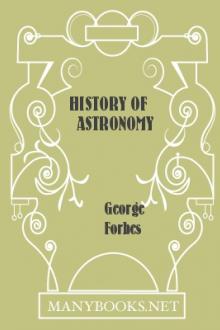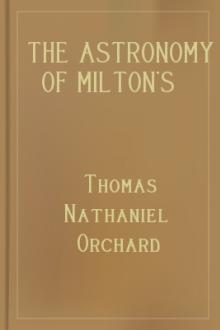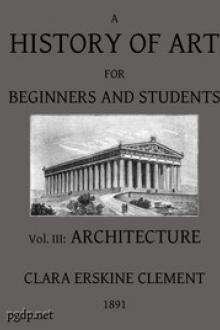History of Astronomy by George Forbes (classic children's novels TXT) 📕

- Author: George Forbes
- Performer: -
Book online «History of Astronomy by George Forbes (classic children's novels TXT) 📕». Author George Forbes
It is often difficult to define the boundaries between fancies, imagination, hypothesis, and sound theory. This extraordinary genius was a master in all these modes of attacking a problem. His analogy between the spaces occupied by the five regular solids and the distances of the planets from the sun, which filled him with so much delight, was a display of pure fancy. His demonstration of the three fundamental laws of planetary motion was the most strict and complete theory that had ever been attempted.
It has been often suggested that the revival by Copernicus of the notion of a moving earth was a help to Kepler. No one who reads Kepler’s great book could hold such an opinion for a moment. In fact, the excellence of Copernicus’s book helped to prolong the life of the epicyclical theories in opposition to Kepler’s teaching.
All of the best theories were compared by him with observation. These were the Ptolemaic, the Copernican, and the Tychonic. The two latter placed all of the planetary orbits concentric with one another, the sun being placed a little away from their common centre, and having no apparent relation to them, and being actually outside the planes in which they move. Kepler’s first great discovery was that the planes of all the orbits pass through the sun; his second was that the line of apses of each planet passes through the sun; both were contradictory to the Copernican theory.
He proceeds cautiously with his propositions until he arrives at his great laws, and he concludes his book by comparing observations of Mars, of all dates, with his theory.
His first law states that the planets describe ellipses with the sun at a focus of each ellipse.
His second law (a far more difficult one to prove) states that a line drawn from a planet to the sun sweeps over equal areas in equal times. These two laws were published in his great work, Astronomia Nova, sen. Physica Coelestis tradita commentariis de Motibus Stelloe; Martis, Prague, 1609.
It took him nine years more[3] to discover his third law, that the squares of the periodic times are proportional to the cubes of the mean distances from the sun.
These three laws contain implicitly the law of universal gravitation. They are simply an alternative way of expressing that law in dealing with planets, not particles. Only, the power of the greatest human intellect is so utterly feeble that the meaning of the words in Kepler’s three laws could not be understood until expounded by the logic of Newton’s dynamics.
The joy with which Kepler contemplated the final demonstration of these laws, the evolution of which had occupied twenty years, can hardly be imagined by us. He has given some idea of it in a passage in his work on Harmonics, which is not now quoted, only lest someone might say it was egotistical—a term which is simply grotesque when applied to such a man with such a life’s work accomplished.
The whole book, Astronomia Nova, is a pleasure to read; the mass of observations that are used, and the ingenuity of the propositions, contrast strongly with the loose and imperfectly supported explanations of all his predecessors; and the indulgent reader will excuse the devotion of a few lines to an example of the ingenuity and beauty of his methods.
It may seem a hopeless task to find out the true paths of Mars and the earth (at that time when their shape even was not known) from the observations giving only the relative direction from night to night. Now, Kepler had twenty years of observations of Mars to deal with. This enabled him to use a new method, to find the earth’s orbit. Observe the date at any time when Mars is in opposition. The earth’s position E at that date gives the longitude of Mars M. His period is 687 days. Now choose dates before and after the principal date at intervals of 687 days and its multiples. Mars is in each case in the same position. Now for any date when Mars is at M and the earth at E3 the date of the year gives the angle E3SM. And the observation of Tycho gives the direction of Mars compared with the sun, SE3M. So all the angles of the triangle SEM in any of these positions of E are known, and also the ratios of SE1, SE2, SE3, SE4 to SM and to each other.
For the orbit of Mars observations were chosen at intervals of a year, when the earth was always in the same place.
[Illustration]
But Kepler saw much farther than the geometrical facts. He realised that the orbits are followed owing to a force directed to the sun; and he guessed that this is the same force as the gravity that makes a stone fall. He saw the difficulty of gravitation acting through the void space. He compared universal gravitation to magnetism, and speaks of the work of Gilbert of Colchester. (Gilbert’s book, De Mundo Nostro Sublunari, Philosophia Nova, Amstelodami, 1651, containing similar views, was published forty-eight years after Gilbert’s death, and forty-two years after Kepler’s book and reference. His book De Magnete was published in 1600.)
A few of Kepler’s views on gravitation, extracted from the Introduction to his Astronomia Nova, may now be mentioned:—
1. Every body at rest remains at rest if outside the attractive power of other bodies.
2. Gravity is a property of masses mutually attracting in such manner that the earth attracts a stone much more than a stone attracts the earth.
3. Bodies are attracted to the earth’s centre, not because it is the centre of the universe, but because it is the centre of the attracting particles of the earth.
4. If the earth be not round (but spheroidal?), then bodies at different latitudes will not be attracted to its centre, but to different points in the neighbourhood of that centre.
5. If the earth and moon were not retained in their orbits by vital force (_aut alia aligua aequipollenti_), the earth and moon would come together.
6. If the earth were to cease to attract its waters, the oceans would all rise and flow to the moon.
7. He attributes the tides to lunar attraction. Kepler had been appointed Imperial Astronomer with a handsome salary (on paper), a fraction of which was doled out to him very irregularly. He was led to miserable makeshifts to earn enough to keep his family from starvation; and proceeded to Ratisbon in 1630 to represent his claims to the Diet. He arrived worn out and debilitated; he failed in his appeal, and died from fever, contracted under, and fed upon, disappointment and exhaustion. Those were not the days when men could adopt as a profession the “research of endowment.”
Before taking leave of Kepler, who was by no means a man of one idea, it ought to be here recorded that he was the first to suggest that a telescope made with both lenses convex (not a Galilean telescope) can have cross wires in the focus, for use as a pointer to fix accurately the positions of stars. An Englishman, Gascoigne, was the first to use this in practice.
From the all too brief epitome here given of Kepler’s greatest book, it must be obvious that he had at that time some inkling of the meaning of his laws—universal gravitation. From that moment the idea of universal gravitation was in the air, and hints and guesses were thrown out by many; and in time the law of gravitation would doubtless have been discovered, though probably not by the work of one man, even if Newton had not lived. But, if Kepler had not lived, who else could have discovered his laws?
FOOTNOTES:
[1] When the writer visited M. D’Arrest, the astronomer, at Copenhagen, in 1872, he was presented by D’Arrest with one of several bricks collected from the ruins of Uraniborg. This was one of his most cherished possessions until, on returning home after a prolonged absence on astronomical work, he found that his treasure had been tidied away from his study.
[2] An ellipse is one of the plane, sections of a cone. It is an oval curve, which may be drawn by fixing two pins in a sheet of paper at S and H, fastening a string, SPH, to the two pins, and stretching it with a pencil point at P, and moving the pencil point, while the string is kept taut, to trace the oval ellipse, APB. S and H are the foci. Kepler found the sun to be in one focus, say S. AB is the major axis. DE is the minor axis. C is the centre. The direction of AB is the line of apses. The ratio of CS to CA is the excentricity. The position of the planet at A is the perihelion (nearest to the sun). The position of the planet at B is the aphelion (farthest from the sun). The angle ASP is the anomaly when the planet is at P. CA or a line drawn from S to D is the mean distance of the planet from the sun.
[Illustration]
[3] The ruled logarithmic paper we now use was not then to be had by going into a stationer’s shop. Else he would have accomplished this in five minutes.
6. GALILEO AND THE TELESCOPE—NOTIONS OF GRAVITY BY HORROCKS, ETC.
It is now necessary to leave the subject of dynamical astronomy for a short time in order to give some account of work in a different direction originated by a contemporary of Kepler’s, his senior in fact by seven years. Galileo Galilei was born at Pisa in 1564. The most scientific part of his work dealt with terrestrial dynamics; but one of those fortunate chances which happen only to really great men put him in the way of originating a new branch of astronomy.
The laws of motion had not been correctly defined. The only man of Galileo’s time who seems to have worked successfully in the same direction as himself was that Admirable Crichton of the Italians, Leonardo da Vinci. Galileo cleared the ground. It had always been noticed that things tend to come to rest; a ball rolled on the ground, a boat moved on the water, a shot fired in the air. Galileo realised that in all of these cases a resisting force acts to stop the motion, and he was the first to arrive at the not very obvious law that the motion of a body will never stop, nor vary its speed, nor change its direction, except by the action of some force.
It is not very obvious that a light body and a heavy one fall at the same speed (except for the resistance of the air). Galileo proved this on paper, but to convince the world he had to experiment from the leaning tower of Pisa.





Comments (0)